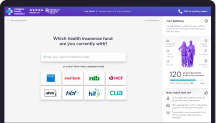ARE YOU EARNING OVER $97,000 PER YEAR? IF YOU DON’T HAVE ADEQUATE PRIVATE HEALTH INSURANCE YOU COULD BE PAYING EXTRA TAX.
The Australian Government introduced the Medicare Levy Surcharge in 1997 to encourage more people to have private health insurance. By taking out private hospital cover|/hospital-cover/, you can not only help reduce the demand on the public health system but also avoid paying additional tax at the end of the financial year.
If you earn over the Medicare Levy thresholds and live without adequate health cover, you’ll be charged a tax at the end of the financial year.
Instead of giving more money to the tax man, why not invest in private hospital insurance that suits your health needs? You'll have the freedom to choose your own doctor and avoid those l
HOW MUCH YOU PAY IN ADDITIONAL TAX WILL ALL DEPEND ON YOUR INCOME BRACKET. BUT YOU COULD POTENTIALLY PAY LESS IF YOU TAKE OUT ADEQUATE HOSPITAL COVER.
To understand how the Medicare Levy Surcharge works and how you can avoid additional tax, we’ve put together the following information, cutting out all the confusion and supplying only the main facts so you can make an informed decision.
Think you have a handle on the basics of health cover? Why not skip ahead and get started with an online quote right now.
In just a few minutes our comparison tool allows you to compare a range of options from health funds.
What is the Medicare Levy Surcharge?
The Medicare Levy Surcharge (MLS) is a tax imposed by the Australian Federal Government designed to alleviate the pressure on the public healthcare system. Here are the two categories:
- If you’re single and start earning over $97,000 a year, you’ll be impacted by the MLS unless you have an adequate hospital cover policy in place.
- If you’re a couple or family with a taxable income of over $194,001 a year, you’ll also have to pay the surcharge if you’re living without private hospital cover.
HOW MAY THE MLS AFFECT ME?
The MLS varies depending on your taxable income bracket. The initial surcharge is 1% and increases to a maximum of 1.5% of your income. How much you earn will determine what MLS level tier you fall into and the surcharge applied.
The Medicare levy calculator works on a day-by-day basis. This means if you take out private hospital cover mid-way through the financial year, you’ll have to pay the MLS for the remaining half of the year.
Want the good news? You can buy a basic level of hospital cover and enjoy all the benefits for around the same price (or possibly less) than what you’d be charged in additional tax.
If you’re not sure whether you can benefit from private hospital insurance, here’s a typical scenario:
You’re single and earning $110,000 a year. You decide to rely on the public hospital system for your treatment or opt to pay for it yourself. As you don’t have private hospital cover, you could be subjected to long waiting lists and you don’t have the choice of doctor or hospital. You may also receive an expensive bill if you choose to fund any medical treatment out of your own pocket.
Without hospital insurance, you’ll have to pay up to $1,000 in MLS at tax time. That money could have potentially bought you private hospital cover.
Should you choose to take out a private hospital cover policy, you could have the option to choose your own doctor and hospital, and may be covered for emergency ambulance transportation. You can schedule your surgery at a time that suits you and you may even be recovering in your own private hospital room.
Best of all, you won’t receive a nasty surprise at tax time!
What are the Medicare Levy thresholds?
The thresholds for the MLS will determine how much you can expect to pay in additional tax if you don’t take out an approved private hospital policy.
Single parents, couples, and those couples living in a de facto relationship fall under the family thresholds.
It’s important to note, the income threshold for families will increase by $1,500 for every dependant child after the first. This means, if you have more than one child you’re able to earn more before incurring the MLS.
| Threshold | Base tier | Tier 1 | Tier 2 | Tier 3 |
|---|---|---|---|---|
| Single threshold | $97,000 or less | $97,001 – $113,000 | $113,001 – $151,000 | $151,001 or more |
| Family threshold | $194,000 or less | $194,001 – $226,000 | $226,001 – $302,000 | $302,001 or more |
| Medicare levy surcharge | 0% | 1% | 1.25% | 1.5% |
How is the Medicare Levy Surcharge Calculated?
The following factors determine how you’re affected by the MLS and the tier you’ll fall under:- Taxable income – this also includes any amount paid towards family trust distribution tax
- Total new investment loss – including net financial investment losses and any rental investment property losses.
- Reportable fringe benefits – this includes all those benefits listed on your end of financial year PAYG payment summary.
- Super contributions – any reportable employer super contributions as well as any personal contributions you make are included.
- Exempt foreign employment income – included if you or your spouse earned a taxable income of $1 or more.
To work out your annual income for MLS purposes, you can use the Australian Taxation Office’s private health insurance rebate calculator or contact the ATO.
How do you avoid the MLS?
If your taxable income has reached the MLS threshold there aren’t any Medicare levy exemptions available to you. The only way you can avoid paying the additional tax is to take out hospital cover. Unless of course, if you take a pay cut!
You also need to take out an adequate private hospital cover to be exempt from the MLS surcharge. Your chosen policy must fulfil the following criteria:
- Be purchased from a registered Australian private health fund.
- Cover some of the total fees and charge for your hospital stay.
- The maximum payable excess must be no greater than $750 per year for singles. The excess on a couples or family policy must be no greater than $1,500 per year.
Will my extras cover help me avoid the MLS?
Unless you have a combined policy, which includes extras and an appropriate level of hospital cover, you’ll still have to pay the MLS. An extras policy alone will not result in a Medicare levy reduction.
Those people holding Overseas Student Health Cover, Overseas Visitors Cover, or health cover with an international insurance provider will also not be exempt from the MLS.
What does Medicare cover?
While Australia has one of the best healthcare systems in the world, beyond tax breaks there are some added benefits of taking out private hospital cover rather than relying solely on Medicare.
Not only will you be helping to alleviate the pressure on the public health system, some people find hospital cover offers a sense of security should something unexpected go wrong with their health.
Of course, you’ll be treated well in the public health system regardless of whether you have cover, but you can enjoy the added benefits such as choosing your own doctor or skipping the lengthy waiting lists.
The best way to decide whether private hospital cover is beneficial for you is to compare. We’ve put together this simple comparison so you can see what Medicare covers versus hospital insurance.
Choose your own doctor
Treated as a private patient in either a public or private hospital
Greater choice when admitted in hospital
You may not have to wait for treatment
Medicare covers 75% of the medical costs under the Medicare Benefits Schedule
A doctor will be appointed to you
Treated as a public patient in a public hospital
You may not be able to choose a hospital for treatment
Treatment is free
Waiting lists apply
The remaining 25% of the medical costs of the MBS fee will be charged to you. Some or all of this will be covered by your insurer.
Other costs incurred may include hospital accommodation, theatre fees, pharmaceuticals and diagnostic tests.
There is no charge for public patients
Medicare will not cover the following treatments:
Private hospital costs, medical or hospital costs incurred overseas, and medical treatment deemed not clinically necessary including cosmetic surgery.
Do I need private health insurance for the whole year?
The MLS is calculated based on the days you don’t have adequate private hospital cover. That means you can’t take out a policy just before tax time and expect to be exempt for the entire financial year.
Here’s a breakdown of one scenario:
- You’re 34 years old, single, and with no kids.
- You’ve decided to take out a private hospital policy in the middle of the 2024-2025 financial year.
- Your total taxable income for the year is $120,000 which means you fall in the Tier 2 income bracket.
- As you were without cover for only 6 months of the year, only half of your income will incur the MLS.
- So, $60,000 x 1.25% = a $750.00 levy payable at tax time.
In the event you receive a pay rise during the year (good for you!) and your income falls into the MLS first tier, it’s worth considering hospital cover, as the days you have a policy will be deducted from your surcharge at tax time.
If you choose to temporarily suspend your private hospital cover (for example, while you’re travelling overseas), you’ll still have to pay the MLS if you’re earning above the threshold for each day you aren’t covered.
In addition to taking out private hospital cover to avoid the MLS, if you’ve just turned 31 and take out cover before the end of the financial year, you can also avoid the Lifetime Health Cover Loading.
Does everyone pay the Medicare Levy?
The Medicare Levy is divided into two parts, each aimed at reducing the pressure on the public healthcare system.
- The Medicare Levy of 2% that is paid by most Australian Taxpayers
- The Medicare Levy Surcharge of 1% to 1.5% applicable for higher income earners who don’t have private hospital cover.
If you don’t have adequate hospital cover and earn over the income threshold, you’ll be paying the Medicare Levy Surcharge in addition to the 2% Medicare Levy (if applicable).
Does the entire family need private hospital cover?
If you are a family and your household’s total taxable income is over the threshold, everyone in your family will require private hospital cover to avoid the MLS. That includes any dependant children.
For example, if your combined income for 2024-2025 was over $194,000 and you don’t have private hospital cover for you, your partner and your children, you’ll pay the MLS of 1%.
For health insurance purposes, dependants are defined as:
1. Child dependant
Up until the age of 21, a dependant who is unmarried and reliant on the policyholder for financial support is considered a ‘child dependant’2. Student dependant
If your child is between 21 and 31 years old, studying full time and unmarried, they’re classified as a ‘student dependant’.3. Adult dependant
For unmarried dependants aged between 21 and 31 years old who aren’t studying full time, they’re considered an ‘adult dependant’. Some funds will charge an additional loading to insure adult dependants under the single parent health policy.
NEXT STEPS
If you’ve decided you no longer want to pay the additional tax of the MLS, it’s time to consider your options for private hospital cover.
The best way to find a hospital cover that meets your health needs and budget is to compare. Using our comparison tool, you can take out all the stress and compare from health funds quickly.
If you’re looking for the most affordable hospital cover simply to avoid the MLS, most funds can offer cheaper options if you’re prepared to pay a higher excess or co-payment when you receive treatment.
All you need to do is jump onto our online comparison site and within a few minutes, you’ll have a range of hospital policies that could see you enjoying the benefits of private health insurance and a tax break!
If you have any questions or queries with your health cover or how the Medicare Levy Surcharge works, we have friendly staff who are all health insurance experts. You can call one of our team on 1300 806 119
FAQs
What is the Medicare Levy Surcharge (MLS), and how does it affect high-income earners?
The Medicare Levy Surcharge is an additional tax imposed by the Australian tax office on individuals who earn above a certain income threshold and do not have adequate private health insurance. It is designed to encourage high-income earners to take out private health cover and reduce the burden on the public healthcare system.
How is the Medicare Levy Surcharge calculated for tax purposes?
The Medicare Levy Surcharge is calculated based on your annual taxable income, including factors such as reportable fringe benefits, total new investment loss, super contributions, and exempt foreign employment income. The surcharge amount varies depending on your income tax bracket for the full financial year, with higher-income earners paying a higher percentage of their income as the surcharge.
Can having a private health insurance policy exempt me from paying the Medicare Levy Surcharge?
having an adequate private health insurance policy can exempt you from paying the Medicare Levy Surcharge. To be eligible for the exemption, the policy must be purchased from a registered Australian private health fund, provide coverage for hospital stays, and have a maximum payable excess that meets the specified limits.
What is the family income threshold for the Medicare Levy Surcharge?
The family income threshold for the Medicare Levy Surcharge is $194,000 per year. If a couple or family's taxable income exceeds this threshold and they do not have adequate private health cover, they will be required to pay the
Can I claim a government rebate on my private health insurance to offset the cost of the Medicare Levy Surcharge?
Yes, you may be eligible for a government rebate on your private health insurance premium. The rebate amount depends on your income and age. However, it's important to note that the rebate cannot be used to offset the Medicare Levy Surcharge. The surcharge is an additional tax separate from the private health insurance rebate.








